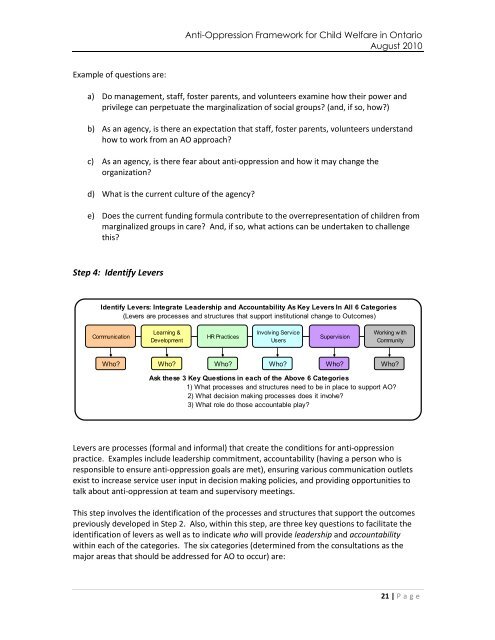An Anti-Oppression Framework for Child Welfare in Ontario
An Anti-Oppression Framework for Child Welfare in Ontario
An Anti-Oppression Framework for Child Welfare in Ontario
You also want an ePaper? Increase the reach of your titles
YUMPU automatically turns print PDFs into web optimized ePapers that Google loves.
<strong>An</strong>ti-<strong>Oppression</strong> <strong>Framework</strong> <strong>for</strong> <strong>Child</strong> <strong>Welfare</strong> <strong>in</strong> <strong>Ontario</strong>August 2010Example of questions are:a) Do management, staff, foster parents, and volunteers exam<strong>in</strong>e how their power andprivilege can perpetuate the marg<strong>in</strong>alization of social groups? (and, if so, how?)b) As an agency, is there an expectation that staff, foster parents, volunteers understandhow to work from an AO approach?c) As an agency, is there fear about anti-oppression and how it may change theorganization?d) What is the current culture of the agency?e) Does the current fund<strong>in</strong>g <strong>for</strong>mula contribute to the overrepresentation of children frommarg<strong>in</strong>alized groups <strong>in</strong> care? <strong>An</strong>d, if so, what actions can be undertaken to challengethis?Step 4: Identify LeversIdentify Levers: Integrate Leadership and Accountability As Key Levers In All 6 Categories(Levers are processes and structures that support <strong>in</strong>stitutional change to Outcomes)CommunicationLearn<strong>in</strong>g &DevelopmentHR PracticesInvolv<strong>in</strong>g ServiceUsersSupervisionWork<strong>in</strong>g w ithCommunityWho?Who?Who? Who? Who? Who?Ask these 3 Key Questions <strong>in</strong> each of the Above 6 Categories1) What processes and structures need to be <strong>in</strong> place to support AO?2) What decision mak<strong>in</strong>g processes does it <strong>in</strong>volve?3) What role do those accountable play?Levers are processes (<strong>for</strong>mal and <strong>in</strong><strong>for</strong>mal) that create the conditions <strong>for</strong> anti-oppressionpractice. Examples <strong>in</strong>clude leadership commitment, accountability (hav<strong>in</strong>g a person who isresponsible to ensure anti-oppression goals are met), ensur<strong>in</strong>g various communication outletsexist to <strong>in</strong>crease service user <strong>in</strong>put <strong>in</strong> decision mak<strong>in</strong>g policies, and provid<strong>in</strong>g opportunities totalk about anti-oppression at team and supervisory meet<strong>in</strong>gs.This step <strong>in</strong>volves the identification of the processes and structures that support the outcomespreviously developed <strong>in</strong> Step 2. Also, with<strong>in</strong> this step, are three key questions to facilitate theidentification of levers as well as to <strong>in</strong>dicate who will provide leadership and accountabilitywith<strong>in</strong> each of the categories. The six categories (determ<strong>in</strong>ed from the consultations as themajor areas that should be addressed <strong>for</strong> AO to occur) are:21 | P a g e
















